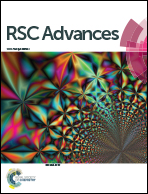Magnetic Prussian blue nanoparticles for combined enzyme-responsive drug release and photothermal therapy†
Abstract
Multifunctional nanoparticles are attracting increasing attention as novel agents for efficient tumor therapy. In this study, a core–shell nanoparticle (NP) system is synthesized by growing gelatin–doxorubicin (Gel–DOX)-stabilized Prussian blue (PB) nanoshells on Fe3O4 nanocores (Fe3O4@PB@Gel–DOX NP), for combined photothermal therapy and enzyme-responsive chemotherapy under magnetic field enhancement. The composite nanoparticles exhibit excellent superparamagnetism (31.6 emu g−1), contributing to their enhanced therapeutic effect under the magnetic field. Drug release from this nanocomplex is triggered in the presence of enzyme in solutions or in live cells. A photothermal effect is evident under near infrared (NIR) laser irradiation, owing to the high photothermal conversion efficiency of the PB nanoshell, resulting in more than 80% cell death of Hela cells treated with 40 μg mL−1 of the nanoparticles. The effects of combining photothermal and drug-induced tumor ablation with magnetic field enhancement are evaluated using a tumor cell viability assay in vitro. It is expected that this nanosystem integrating superparamagnetism, photothermal therapy and chemotherapy will foster new avenues for developing the next generation of multifunctional platforms towards effective cancer treatment.


 Please wait while we load your content...
Please wait while we load your content...